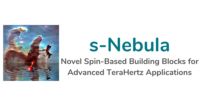Broadband Terahertz Probes of Anisotropic Magnetoresistance Disentangle Extrinsic and Intrinsic Contributions
Abstract: Anisotropic magnetoresistance (AMR) is a ubiquitous and versatile probe of magnetic order in contemporary spintronics research. Its origins are usually ascribed to extrinsic effects (i.e., spin-dependent electron scattering), whereas intrinsic (i.e., scattering-independent) contributions are neglected. Here, we measure AMR of polycrystalline thin films of the standard ferromagnets Co, Ni, Ni81Fe19, and Ni50Fe50 over the frequency range from dc to 28 THz. The large bandwidth covers the regimes of both diffusive and ballistic intraband electron transport and, thus, allows us to separate extrinsic and intrinsic AMR components. Analysis of the THz response based on Boltzmann transport theory reveals that the AMR of the Ni, Ni81Fe19, and Ni50Fe50 samples is of predominantly extrinsic nature. However, the Co thin film exhibits a sizable intrinsic AMR contribution, which is constant up to 28 THz and amounts to more than 2/3 of the dc AMR contrast of 1%. These features are attributed to the hexagonal structure of the Co crystallites. They are interesting for applications in terahertz spintronics and terahertz photonics. Our results show that broadband terahertz electromagnetic pulses provide new and contact-free insights into magnetotransport phenomena of standard magnetic thin films on ultrafast timescales.
